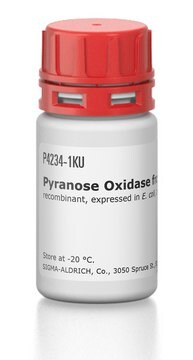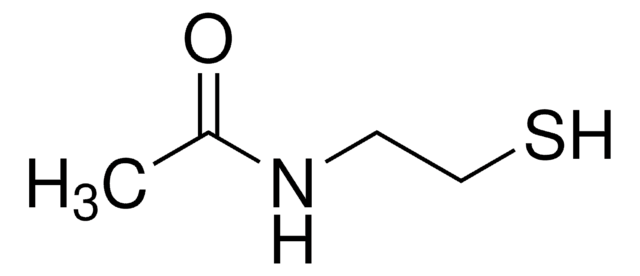Kluczowe dokumenty
30080
Cysteamine hydrochloride
≥97.0% (RT)
Synonim(y):
β-Mercaptoethylamine hydrochloride, 2-Aminoethanethiol hydrochloride, 2-Mercaptoethylamine hydrochloride, Decarboxycysteine hydrochloride, Thioethanolamine hydrochloride
About This Item
Polecane produkty
Poziom jakości
Próba
≥97.0% (RT)
Formularz
crystals
mp
64-70 °C
67-71 °C
temp. przechowywania
2-8°C
ciąg SMILES
Cl[H].NCCS
InChI
1S/C2H7NS.ClH/c3-1-2-4;/h4H,1-3H2;1H
Klucz InChI
OGMADIBCHLQMIP-UHFFFAOYSA-N
Szukasz podobnych produktów? Odwiedź Przewodnik dotyczący porównywania produktów
Zastosowanie
Działania biochem./fizjol.
Hasło ostrzegawcze
Warning
Zwroty wskazujące rodzaj zagrożenia
Zwroty wskazujące środki ostrożności
Klasyfikacja zagrożeń
Acute Tox. 4 Oral - Eye Irrit. 2 - Skin Sens. 1 - STOT SE 3
Organy docelowe
Respiratory system
Kod klasy składowania
11 - Combustible Solids
Klasa zagrożenia wodnego (WGK)
WGK 3
Temperatura zapłonu (°F)
Not applicable
Temperatura zapłonu (°C)
Not applicable
Środki ochrony indywidualnej
dust mask type N95 (US), Eyeshields, Gloves
Wybierz jedną z najnowszych wersji:
Masz już ten produkt?
Dokumenty związane z niedawno zakupionymi produktami zostały zamieszczone w Bibliotece dokumentów.
Klienci oglądali również te produkty
Nasz zespół naukowców ma doświadczenie we wszystkich obszarach badań, w tym w naukach przyrodniczych, materiałoznawstwie, syntezie chemicznej, chromatografii, analityce i wielu innych dziedzinach.
Skontaktuj się z zespołem ds. pomocy technicznej









